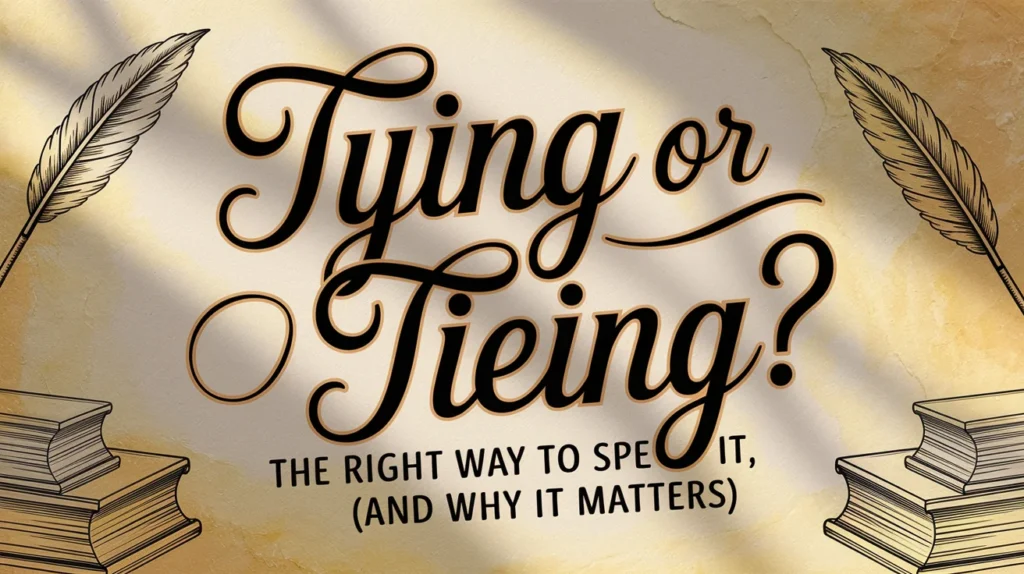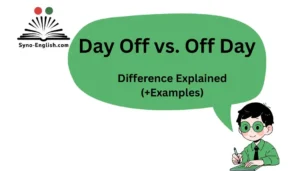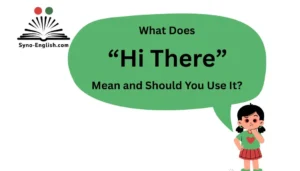We all know how tricky spelling can be in the English language. There are countless rules, exceptions, and oddities that make it harder than it seems at first glance. A prime example?
The debate between “tying” or “tieing.” It’s something many people get wrong, and although it might seem like a small mistake, using the wrong spelling can affect your credibility—especially in writing that requires precision.
But don’t worry; by the end of this article, you’ll never wonder about this again. Let’s break down the real reason “tying” is correct, why “tieing” isn’t, and how to spot similar spelling pitfalls in English.
Spelling Mistakes You Didn’t Know You Were Making
You’ve probably encountered “tieing” at some point, whether you’ve seen it in an email, read it in a book, or even typed it yourself. It feels right, doesn’t it? After all, words like “die” become “dying,” so why shouldn’t “tie” become “tieing”? But as much as it might seem logical, “tieing” is not the proper spelling.
In this article, we’ll explore why “tying” is the only correct way to spell this word, how English spelling rules cause confusion, and share some tips for remembering the difference. We’ll also dive into other tricky spelling rules in English so you can feel more confident in your writing. Let’s unravel this mystery and clear up any doubts for good.
The Correct Spelling: It’s “Tying”
At its core, the confusion between “tying” and “tieing” comes down to a simple rule of English spelling: when a word ends in a silent “e” and you add “-ing,” you drop the “e”.
This rule applies to many English words, including “tie.” The correct spelling is “tying”. It follows the same rule as verbs like “making”, “going”, and “singing”, where the “e” is dropped before adding “-ing.”
Examples:
- Tying your shoes
- Tying a knot
- Tying the score in a game
When you follow this rule, you’re correctly forming the present participle of “tie.” “Tying” is the only accepted spelling in modern English.
Why “Tieing” Seems Right (But Isn’t)
So, why does “tieing” seem like a reasonable spelling to many people? One reason lies in the pattern of other verbs in English that don’t drop the “e.” Words like “see” → “seeing” and “agree” → “agreeing” create a sense of consistency, which leads us to believe that “tieing” might work the same way. However, English is a language full of exceptions, and “tie” is one of them.
Here’s a fun fact: “Tieing” is a common misspelling, and people often use it because the sound and structure of “tie” might trick us into thinking it should follow the same rule as “see” or “agree.”
But remember, “tie” ends with a silent “e,” and the rule says that silent “e” gets dropped when adding “-ing.” This makes “tying” the correct spelling.
English Spelling Rules: Drop the Silent “E”
To further explain why “tieing” is incorrect, let’s look at the broader rule. English has a general spelling rule when it comes to adding the suffix “-ing” to verbs that end in a silent “e”: you drop the “e”.
Here’s the rule in action:
Correct Examples:
- Make → Making
- Bake → Baking
- Tie → Tying
- Drive → Driving
Incorrect Examples:
- Tieing (Incorrect)
- Bakinge (Incorrect)
The “e” gets dropped in these cases to maintain the flow of the word and prevent unnecessary vowel repetition.
Exceptions:
While the rule holds true in most cases, there are a few exceptions in English where the “e” is not dropped, such as when the word ends in a hard “g” sound (as in “ageing” in British English). However, these exceptions are rare and don’t apply to the case of “tie.”
“Tying” in Action: Common Phrases and Examples
Now that we know the correct spelling is “tying,” let’s look at some real-world examples to see how it fits into everyday language.
Here are some commonly used phrases where “tying” is the correct choice:
- Tying your shoes – The classic example, the act of fastening your shoes with laces.
- Tying a knot – Securing a rope or string with a knot.
- Tying the knot – A common idiomatic expression meaning getting married.
- Tying up loose ends – Finishing off tasks or details, especially after a project or event.
These examples show how “tying” is used in everyday life. It’s the go-to word in a variety of contexts, from casual activities to important life events.
What About “Tieing”? Has It Ever Been Correct?
In modern English, “tieing” is not accepted, but does it have any historical validity? Surprisingly, “tieing” did appear in older texts—though not frequently.
However, over time, “tieing” became increasingly rare and was replaced by “tying”. According to the Google Ngram Viewer, which tracks the usage of words and phrases in books, “tieing” has been in steady decline, while “tying” has remained dominant for centuries.
While older English texts might have used “tieing,” it is now regarded as incorrect in modern English. It’s clear that language evolves, and in this case, “tying” emerged as the standard spelling.
Memory Hacks to Remember “Tying”
Learning spelling rules can be challenging, but here are some memory hacks to make it easier to remember “tying”:
- “If it ends in ‘e’, let it flee before adding -ing.”
This simple rhyme can help you remember that when a word ends with a silent “e,” you should drop it before adding “-ing.” - Visualize the Word
Picture “tie” as the base word, and when you add “-ing,” you can visualize the “e” falling off as you write it out. This simple mental image can help reinforce the rule. - Compare Similar Words
Think of other verbs that follow the same pattern, like die → dying, lie → lying, tie → tying. Recognizing the consistency across these words can help solidify the rule.
Other Tricky Verbs That Follow the Same Rule
If you’re worried about getting caught in other tricky spelling situations, don’t fret. Here’s a list of other verbs that follow the same “drop the e before -ing” rule:
Common Examples:
- Die → Dying
- Lie → Lying
- Tie → Tying
- Ride → Riding
- Bake → Baking
- Make → Making
Exceptions:
- Ageing (British spelling)
- Singeing (Noticing the “e” is kept here for specific reasons)
By memorizing these, you’ll be able to spot the pattern in other words with similar endings.
Quick Recap & Takeaway
- “Tying” is the correct spelling.
- The “e” gets dropped when adding “-ing” to words like “tie,” “make,” and “bake.”
- Use “tying” in all instances, and remember: “tieing” is incorrect in modern English.
With these rules in mind, you’ll be able to confidently use “tying” in any situation—whether you’re tying your shoes, tying a knot, or tying up loose ends in your writing.
Conclusion: Spelling Smarter, One Word at a Time
By now, you should feel confident in your ability to spell “tying” correctly. It’s a small thing, but paying attention to these details in your writing can make a big difference. If you’ve ever struggled with this spelling, you can now walk away with the knowledge that “tying” is the only correct form in modern English.
And if you ever get caught up on another confusing word, remember: spelling rules are here to help, and with a little practice, you’ll always get it right.
FAQ Section
Q: Is “tieing” ever used in British English?
A: No, “tieing” is not used in British English either. The correct spelling is always “tying” in both American and British English.
Q: Why do some grammar checkers miss this mistake?
A: Grammar checkers sometimes miss nuances in language, especially with less common errors. It’s always best to double-check your spelling manually, especially for tricky words like “tying.”
Q: What’s the difference between “tying” and “tie-in”?
A: “Tying” refers to the act of binding or fastening, while “tie-in” refers to a related product or promotion, like a book or movie release that’s linked to a brand or event.
Q: Are there exceptions to the drop-the-e rule?
A: Yes, but they are rare. One notable example is the British English spelling “ageing”.

Emma Brooke is a passionate English educator, writer, and language enthusiast with over a decade of experience helping learners master the nuances of the English language. At SynoEnglish, she blends practical grammar advice with real-world communication tips to make English easier, clearer, and more enjoyable for readers of all levels.



